concurrent-pkg
ConcurrentHashMap
三种集合:
- HashMap 是线程不安全的,性能好
- Hashtable 线程安全基于 synchronized,综合性能差,已经被淘汰
- ConcurrentHashMap 保证了线程安全,综合性能较好,不止线程安全,而且效率高,性能好
集合对比:
- Hashtable 继承 Dictionary 类,HashMap、ConcurrentHashMap 继承 AbstractMap,均实现 Map 接口
- Hashtable 底层是数组 + 链表,JDK8 以后 HashMap 和 ConcurrentHashMap 底层是数组 + 链表 + 红黑树
- HashMap 线程非安全,Hashtable 线程安全,Hashtable 的方法都加了 synchronized 关来确保线程同步
- ConcurrentHashMap、Hashtable 不允许 null 值,HashMap 允许 null 值
- ConcurrentHashMap、HashMap 的初始容量为 16,Hashtable 初始容量为11,填充因子默认都是 0.75,两种 Map 扩容是当前容量翻倍:capacity * 2,Hashtable 扩容时是容量翻倍 + 1:capacity*2 + 1
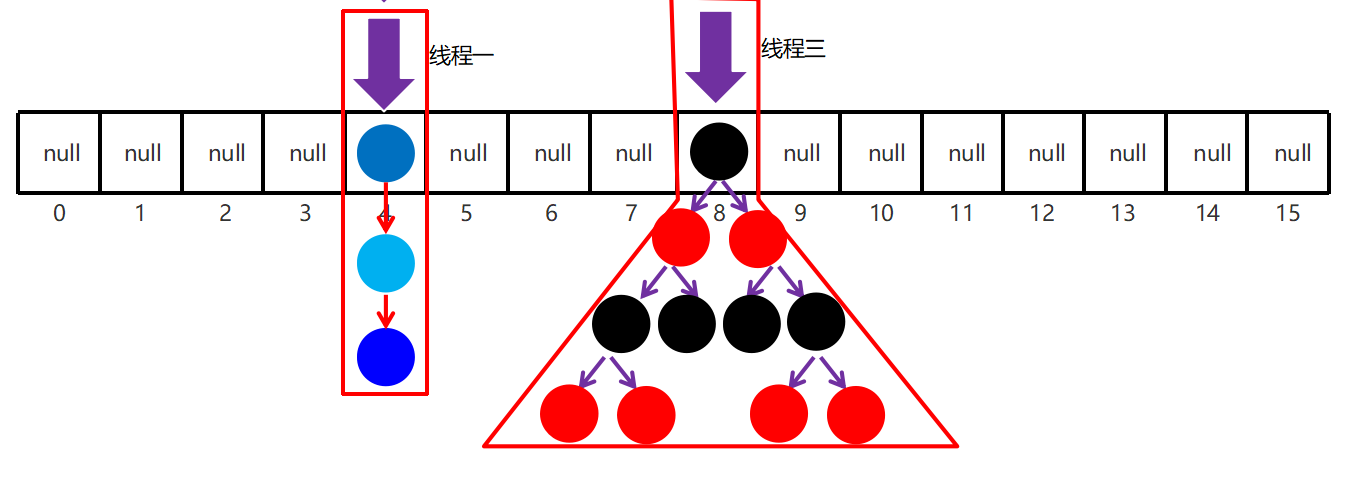
工作步骤:
初始化,使用 cas 来保证并发安全,懒惰初始化 table
树化,当 table.length < 64 时,先尝试扩容,超过 64 时,并且 bin.length > 8 时,会将链表树化,树化过程会用 synchronized 锁住链表头
说明: 锁住某个槽位的对象头,是一种很好的细粒度的加锁方式,类似 MySQL 中的行锁
put,如果该 bin 尚未创建,只需要使用 cas 创建 bin;如果已经有了,锁住链表头进行后续 put 操作,元素添加至 bin 的尾部
get,无锁操作仅需要保证可见性,扩容过程中 get 操作拿到的是 ForwardingNode 会让 get 操作在新 table 进行搜索
扩容,扩容时以 bin 为单位进行,需要对 bin 进行 synchronized,但这时其它竞争线程也不是无事可做,它们会帮助把其它 bin 进行扩容
size,元素个数保存在 baseCount 中,并发时的个数变动保存在 CounterCell[] 当中,最后统计数量时累加
并发死链
JDK1.7 的 HashMap 采用的头插法(拉链法)进行节点的添加,HashMap 的扩容长度为原来的 2 倍,JDK 8 虽然将扩容算法做了调整,改用了尾插法,但仍不意味着能够在多线程环境下能够安全扩容,还会出现其它问题(如扩容丢数据)。
resize() 中节点(Entry)转移的源代码:
1 | void transfer(Entry[] newTable, boolean rehash) { |
成员属性
存储数组:
1
transient volatile Node<K,V>[] table;
散列表的长度:
1
2private static final int MAXIMUM_CAPACITY = 1 << 30; // 最大长度
private static final int DEFAULT_CAPACITY = 16; // 默认长度并发级别,JDK7 遗留下来,1.8 中不代表并发级别:
1
private static final int DEFAULT_CONCURRENCY_LEVEL = 16;
负载因子,JDK1.8 的 ConcurrentHashMap 中是固定值:
1
private static final float LOAD_FACTOR = 0.75f;
阈值:
1
2
3static final int TREEIFY_THRESHOLD = 8; // 链表树化的阈值
static final int UNTREEIFY_THRESHOLD = 6; // 红黑树转化为链表的阈值
static final int MIN_TREEIFY_CAPACITY = 64; // 当数组长度达到64且某个桶位中的链表长度超过8,才会真正树化扩容相关:
1
2
3
4private static final int MIN_TRANSFER_STRIDE = 16; // 线程迁移数据【最小步长】,控制线程迁移任务的最小区间
private static int RESIZE_STAMP_BITS = 16; // 用来计算扩容时生成的【标识戳】
private static final int MAX_RESIZERS = (1 << (32 - RESIZE_STAMP_BITS)) - 1;// 65535-1并发扩容最多线程数
private static final int RESIZE_STAMP_SHIFT = 32 - RESIZE_STAMP_BITS; // 扩容时使用节点哈希值:
1
2
3
4static final int MOVED = -1; // 表示当前节点是 FWD 节点
static final int TREEBIN = -2; // 表示当前节点已经树化,且当前节点为 TreeBin 对象
static final int RESERVED = -3; // 表示节点时临时节点
static final int HASH_BITS = 0x7fffffff; // 正常节点的哈希值的可用的位数扩容过程:volatile 修饰保证多线程的可见性
1
2
3
4// 扩容过程中,会将扩容中的新 table 赋值给 nextTable 保持引用,扩容结束之后,这里会被设置为 null
private transient volatile Node<K,V>[] nextTable;
// 记录扩容进度,所有线程都要从 0 - transferIndex 中分配区间任务,简单说就是老表转移到哪了,索引从高到低转移
private transient volatile int transferIndex;累加统计:
1
2
3
4
5
6// LongAdder 中的 baseCount 未发生竞争时或者当前LongAdder处于加锁状态时,增量累到到 baseCount 中
private transient volatile long baseCount;
// LongAdder 中的 cellsBuzy,0 表示当前 LongAdder 对象无锁状态,1 表示当前 LongAdder 对象加锁状态
private transient volatile int cellsBusy;
// LongAdder 中的 cells 数组,
private transient volatile CounterCell[] counterCells;控制变量:
sizeCtl < 0:
- -1 表示当前 table 正在初始化(有线程在创建 table 数组),当前线程需要自旋等待
- 其他负数表示当前 map 的 table 数组正在进行扩容,高 16 位表示扩容的标识戳;低 16 位表示 (1 + nThread) 当前参与并发扩容的线程数量 + 1
sizeCtl = 0,表示创建 table 数组时使用 DEFAULT_CAPACITY 为数组大小
sizeCtl > 0:
- 如果 table 未初始化,表示初始化大小
- 如果 table 已经初始化,表示下次扩容时的触发条件(阈值,元素个数,不是数组的长度)
1
private transient volatile int sizeCtl; // volatile 保持可见性
内部类
1 | static class Node<K,V> implements Entry<K,V> { |
1 | static final class TreeBin<K,V> extends Node<K,V> { |
1 | static final class TreeNode<K,V> extends Node<K,V> { |
1 | static final class ForwardingNode<K,V> extends Node<K,V> { |
代码块
1 | // 表示sizeCtl属性在 ConcurrentHashMap 中内存偏移地址 |
1 | // 表示数组单元所占用空间大小,scale 表示 Node[] 数组中每一个单元所占用空间大小,int 是 4 字节 |
构造方法
无参构造, 散列表结构延迟初始化,默认的数组大小是 16:
1
2public ConcurrentHashMap() {
}有参构造:
1
2
3
4
5
6
7
8
9
10
11public ConcurrentHashMap(int initialCapacity) {
// 指定容量初始化
if (initialCapacity < 0) throw new IllegalArgumentException();
int cap = ((initialCapacity >= (MAXIMUM_CAPACITY >>> 1)) ?
MAXIMUM_CAPACITY :
// 假如传入的参数是 16,16 + 8 + 1 ,最后得到 32
// 传入 12, 12 + 6 + 1 = 19,最后得到 32,尽可能的大,与 HashMap不一样
tableSizeFor(initialCapacity + (initialCapacity >>> 1) + 1));
// sizeCtl > 0,当目前 table 未初始化时,sizeCtl 表示初始化容量
this.sizeCtl = cap;
}1
2
3
4
5
6
7
8
9private static final int tableSizeFor(int c) {
int n = c - 1;
n |= n >>> 1;
n |= n >>> 2;
n |= n >>> 4;
n |= n >>> 8;
n |= n >>> 16;
return (n < 0) ? 1 : (n >= MAXIMUM_CAPACITY) ? MAXIMUM_CAPACITY : n + 1;
}HashMap 部分详解了该函数,核心思想就是把最高位是 1 的位以及右边的位全部置 1,结果加 1 后就是 2 的 n 次幂
多个参数构造方法:
1
2
3
4
5
6
7
8
9
10
11
12
13
14public ConcurrentHashMap(int initialCapacity, float loadFactor, int concurrencyLevel) {
if (!(loadFactor > 0.0f) || initialCapacity < 0 || concurrencyLevel <= 0)
throw new IllegalArgumentException();
// 初始容量小于并发级别
if (initialCapacity < concurrencyLevel)
// 把并发级别赋值给初始容量
initialCapacity = concurrencyLevel;
// loadFactor 默认是 0.75
long size = (long)(1.0 + (long)initialCapacity / loadFactor);
int cap = (size >= (long)MAXIMUM_CAPACITY) ?
MAXIMUM_CAPACITY : tableSizeFor((int)size);
// sizeCtl > 0,当目前 table 未初始化时,sizeCtl 表示初始化容量
this.sizeCtl = cap;
}集合构造方法:
1
2
3
4
5
6
7
8
9
10
11
12
13
14
15
16
17
18
19
20
21
22
23
24
25
26
27
28
29
30
31
32
33
34
35
36
37
38
39
40
41
42public ConcurrentHashMap(Map<? extends K, ? extends V> m) {
this.sizeCtl = DEFAULT_CAPACITY; // 默认16
putAll(m);
}
public void putAll(Map<? extends K, ? extends V> m) {
// 尝试触发扩容
tryPresize(m.size());
for (Entry<? extends K, ? extends V> e : m.entrySet())
putVal(e.getKey(), e.getValue(), false);
}
private final void tryPresize(int size) {
// 扩容为大于 2 倍的最小的 2 的 n 次幂
int c = (size >= (MAXIMUM_CAPACITY >>> 1)) ? MAXIMUM_CAPACITY :
tableSizeFor(size + (size >>> 1) + 1);
int sc;
while ((sc = sizeCtl) >= 0) {
Node<K,V>[] tab = table; int n;
// 数组还未初始化,【一般是调用集合构造方法才会成立,put 后调用该方法都是不成立的】
if (tab == null || (n = tab.length) == 0) {
n = (sc > c) ? sc : c;
if (U.compareAndSwapInt(this, SIZECTL, sc, -1)) {
try {
if (table == tab) {
Node<K,V>[] nt = (Node<K,V>[])new Node<?,?>[n];
table = nt;
sc = n - (n >>> 2);// 扩容阈值:n - 1/4 n
}
} finally {
sizeCtl = sc; // 扩容阈值赋值给sizeCtl
}
}
}
// 未达到扩容阈值或者数组长度已经大于最大长度
else if (c <= sc || n >= MAXIMUM_CAPACITY)
break;
// 与 addCount 逻辑相同
else if (tab == table) {
}
}
}
成员方法
数据访存
tabAt():获取数组某个槽位的头节点,类似于数组中的直接寻址 arr[i]
1
2
3
4
5// i 是数组索引
static final <K,V> Node<K,V> tabAt(Node<K,V>[] tab, int i) {
// (i << ASHIFT) + ABASE == ABASE + i * 4 (一个 int 占 4 个字节),这就相当于寻址,替代了乘法
return (Node<K,V>)U.getObjectVolatile(tab, ((long)i << ASHIFT) + ABASE);
}casTabAt():指定数组索引位置修改原值为指定的值
1
2
3static final <K,V> boolean casTabAt(Node<K,V>[] tab, int i, Node<K,V> c, Node<K,V> v) {
return U.compareAndSwapObject(tab, ((long)i << ASHIFT) + ABASE, c, v);
}setTabAt():指定数组索引位置设置值
1
2
3static final <K,V> void setTabAt(Node<K,V>[] tab, int i, Node<K,V> v) {
U.putObjectVolatile(tab, ((long)i << ASHIFT) + ABASE, v);
}
添加方法
1 | public V put(K key, V value) { |
1 | final V putVal(K key, V value, boolean onlyIfAbsent) { |
1 | // 扰动函数,将 hashCode 无符号右移 16 位,高 16bit 和低 16bit 做异或,最后与 HASH_BITS 相与变成正数, |
1 | // 初始化数组,延迟初始化 |
1 | // 树化方法 |
1 | // 添加计数,代表哈希表中的数据总量 |
1 | /** |
扩容方法
- 当链表中元素个数超过 8 个,数组的大小还未超过 64 时,此时进行数组的扩容,如果超过则将链表转化成红黑树
- put 数据后调用 addCount() 方法,判断当前哈希表的容量超过阈值 sizeCtl,超过进行扩容
- 增删改线程发现其他线程正在扩容,帮其扩容
1 | // 数据转移到新表中,完成扩容 |
1 | // 帮助扩容 |
链表处理的 LastRun 机制,可以减少节点的创建
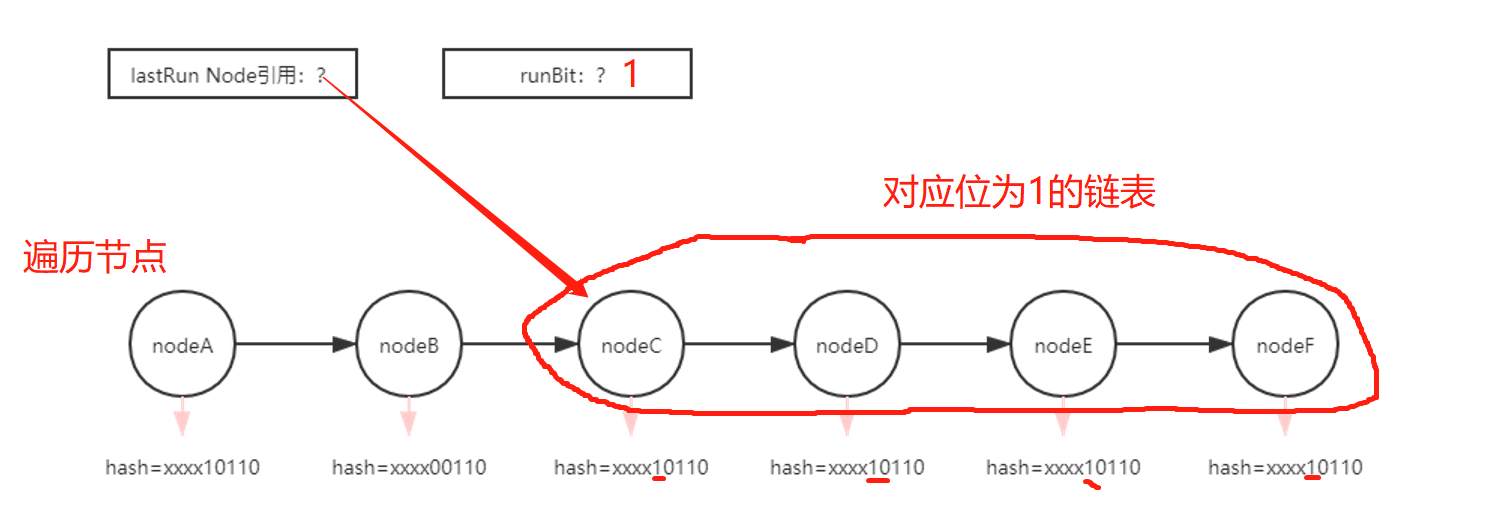
获取方法
1 | public V get(Object key) { |
1 | // ForwardingNode#find:转移节点的查找方法 |
删除方法
1 | public V remove(Object key) { |
1 | // 替代指定的元素,会协助扩容,增删改(写)都会协助扩容,查询(读)操作不会,因为读操作不涉及加锁 |
CopyOnWrite
CopyOnWriteArrayList 采用了写入时拷贝的思想,增删改操作会将底层数组拷贝一份,在新数组上执行操作,不影响其它线程的并发读,读写分离,CopyOnWriteArraySet 底层对 CopyOnWriteArrayList 进行了包装,装饰器模式
1 | public CopyOnWriteArraySet() { |
1 | // 需要加锁,创建新的数组操作 |
1 | // 不加锁,在原数组上操作, 适合读多写少的应用场景 |
1 | // CopyOnWriteArrayList 在返回迭代器时,创建一个内部数组当前的快照(引用),即使其他线程替换了原始数组, |
弱一致性
数据一致性就是读到最新更新的数据:
- 强一致性:当更新操作完成之后,任何多个后续进程或者线程的访问都会返回最新的更新过的值
- 弱一致性:系统并不保证进程或者线程的访问都会返回最新的更新过的值,也不会承诺多久之后可以读到
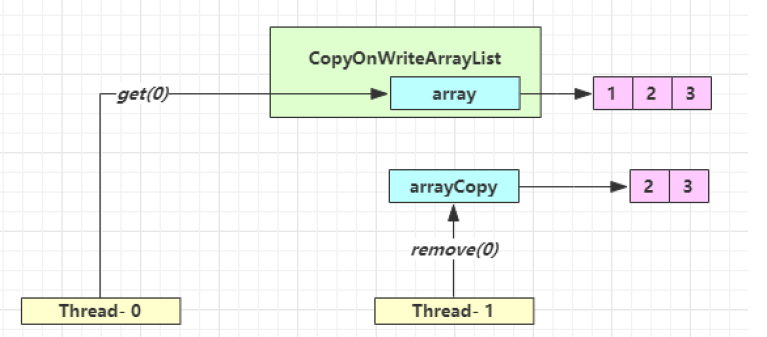
| 时间点 | 操作 |
|---|---|
| 1 | Thread-0 getArray() |
| 2 | Thread-1 getArray() |
| 3 | Thread-1 setArray(arrayCopy) |
| 4 | Thread-0 array[index] |
Thread-0 读到了脏数据
不一定弱一致性就不好
- 数据库的事务隔离级别就是弱一致性的表现
- 并发高和一致性是矛盾的,需要权衡
安全失败
在 java.util 包的集合类就都是快速失败的,而 java.util.concurrent 包下的类都是安全失败
快速失败:在 A 线程使用迭代器对集合进行遍历的过程中,此时 B 线程对集合进行修改(增删改),或者 A 线程在遍历过程中对集合进行修改,都会导致 A 线程抛出 ConcurrentModificationException 异常
- AbstractList 类中的成员变量 modCount,用来记录 List 结构发生变化的次数,结构发生变化是指添加或者删除至少一个元素的操作,或者是调整内部数组的大小,仅仅设置元素的值不算结构发生变化
- 在进行序列化或者迭代等操作时,需要比较操作前后 modCount 是否改变,如果改变了抛出 CME 异常
安全失败:采用安全失败机制的集合容器,在迭代器遍历时直接在原集合数组内容上访问,但其他线程的增删改都会新建数组进行修改,就算修改了集合底层的数组容器,迭代器依然引用着以前的数组(快照思想),所以不会出现异常
ConcurrentHashMap 不会出现并发时的迭代异常,因为在迭代过程中 CHM 的迭代器并没有判断结构的变化,迭代器还可以根据迭代的节点状态去寻找并发扩容时的新表进行迭代
1
2
3ConcurrentHashMap map = new ConcurrentHashMap();
// KeyIterator
Iterator iterator = map.keySet().iterator();1
2
3
4
5
6
7
8Traverser(Node<K,V>[] tab, int size, int index, int limit) {
// 引用还是原来集合的 Node 数组,所以其他线程对数据的修改是可见的
this.tab = tab;
this.baseSize = size;
this.baseIndex = this.index = index;
this.baseLimit = limit;
this.next = null;
}1
2
3
4
5
6
7
8
9
10
11public final boolean hasNext() { return next != null; }
public final K next() {
Node<K,V> p;
if ((p = next) == null)
throw new NoSuchElementException();
K k = p.key;
lastReturned = p;
// 在方法中进行下一个节点的获取,会进行槽位头节点的状态判断
advance();
return k;
}
SkipListMap
跳表 SkipList 是一个有序的链表,默认升序,底层是链表加多级索引的结构。跳表可以对元素进行快速查询,类似于平衡树,是一种利用空间换时间的算法
对于单链表,即使链表是有序的,如果查找数据也只能从头到尾遍历链表,所以采用链表上建索引的方式提高效率,跳表的查询时间复杂度是 **O(logn)**,空间复杂度 O(n)
ConcurrentSkipListMap 提供了一种线程安全的并发访问的排序映射表,内部是跳表结构实现,通过 CAS + volatile 保证线程安全
平衡树和跳表的区别:
- 对平衡树的插入和删除往往很可能导致平衡树进行一次全局的调整;而对跳表的插入和删除,只需要对整个结构的局部进行操作
- 在高并发的情况下,保证整个平衡树的线程安全需要一个全局锁;对于跳表则只需要部分锁,拥有更好的性能

BaseHeader 存储数据,headIndex 存储索引,纵向上所有索引都指向链表最下面的节点
成员变量
标识索引头节点位置
1
private static final Object BASE_HEADER = new Object();
跳表的顶层索引
1
private transient volatile HeadIndex<K,V> head;
比较器,为 null 则使用自然排序
1
final Comparator<? super K> comparator;
Node 节点
1
2
3
4
5static final class Node<K, V>{
final K key; // key 是 final 的, 说明节点一旦定下来, 除了删除, 一般不会改动 key
volatile Object value; // 对应的 value
volatile Node<K, V> next; // 下一个节点,单向链表
}索引节点 Index,只有向下和向右的指针
1
2
3
4
5
6
7
8
9
10
11
12
13
14
15
16
17
18static class Index<K, V>{
final Node<K, V> node; // 索引指向的节点,每个都会指向数据节点
final Index<K, V> down; // 下边level层的Index,分层索引
volatile Index<K, V> right; // 右边的Index,单向
// 在 index 本身和 succ 之间插入一个新的节点 newSucc
final boolean link(Index<K, V> succ, Index<K, V> newSucc){
Node<K, V> n = node;
newSucc.right = succ;
// 把当前节点的右指针从 succ 改为 newSucc
return n.value != null && casRight(succ, newSucc);
}
// 断开当前节点和 succ 节点,将当前的节点 index 设置其的 right 为 succ.right,就是把 succ 删除
final boolean unlink(Index<K, V> succ){
return node.value != null && casRight(succ, succ.right);
}
}头索引节点 HeadIndex
1
2
3
4
5
6
7static final class HeadIndex<K,V> extends Index<K,V> {
final int level; // 表示索引层级,所有的 HeadIndex 都指向同一个 Base_header 节点
HeadIndex(Node<K,V> node, Index<K,V> down, Index<K,V> right, int level) {
super(node, down, right);
this.level = level;
}
}
成员方法
1 | public ConcurrentSkipListMap() { |
1 | private void initialize() { |
1 | // x 是比较者,y 是被比较者,比较者大于被比较者 返回正数,小于返回负数,相等返回 0 |
添加方法
findPredecessor():寻找前置节点
从最上层的头索引开始向右查找(链表的后续索引),如果后续索引的节点的 key 大于要查找的 key,则头索引移到下层链表,在下层链表查找,以此反复,一直查找到没有下层的分层索引为止,返回该索引的节点。如果后续索引的节点的 key 小于要查找的 key,则在该层链表中向后查找。由于查找的 key 可能永远大于索引节点的 key,所以只能找到目标的前置索引节点。如果遇到空值索引的存在,通过 CAS 来断开索引
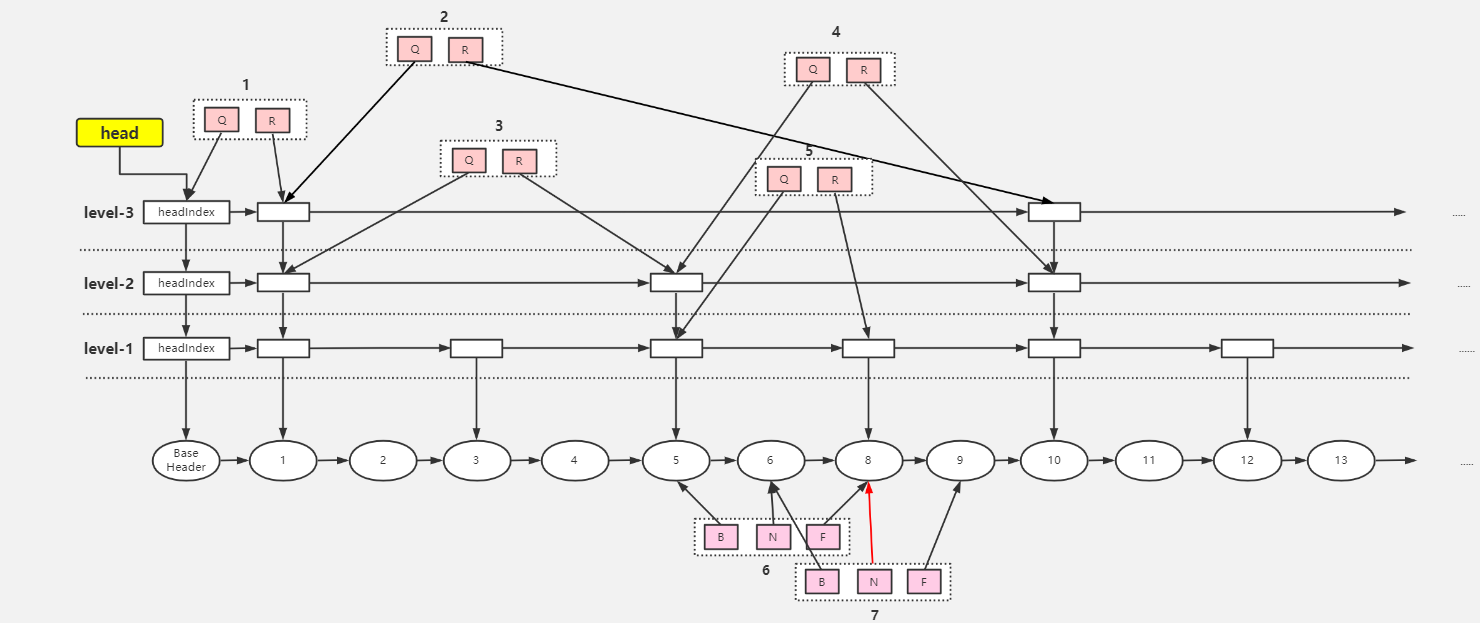
1
2
3
4
5
6
7
8
9
10
11
12
13
14
15
16
17
18
19
20
21
22
23
24
25
26
27
28
29
30
31
32
33
34
35
36
37
38
39private Node<K,V> findPredecessor(Object key, Comparator<? super K> cmp) {
if (key == null)
throw new NullPointerException(); // don't postpone errors
for (;;) {
// 1.初始数据 q 是 head,r 是最顶层 h 的右 Index 节点
for (Index<K,V> q = head, r = q.right, d;;) {
// 2.右索引节点不为空,则进行向下查找
if (r != null) {
Node<K,V> n = r.node;
K k = n.key;
// 3.n.value 为 null 说明节点 n 正在删除的过程中,此时【当前线程帮其删除索引】
if (n.value == null) {
// 在 index 层直接删除 r 索引节点
if (!q.unlink(r))
// 删除失败重新从 head 节点开始查找,break 一个 for 到步骤 1,又从初始值开始
break;
// 删除节点 r 成功,获取新的 r 节点,
r = q.right;
// 回到步骤 2,还是从这层索引开始向右遍历
continue;
}
// 4.若参数 key > r.node.key,则继续向右遍历, continue 到步骤 2 处获取右节点
// 若参数 key < r.node.key,说明需要进入下层索引,到步骤 5
if (cpr(cmp, key, k) > 0) {
q = r;
r = r.right;
continue;
}
}
// 5.先让 d 指向 q 的下一层,判断是否是 null,是则说明已经到了数据层,也就是第一层
if ((d = q.down) == null)
return q.node;
// 6.未到数据层, 进行重新赋值向下扫描
q = d; // q 指向 d
r = d.right;// r 指向 q 的后续索引节点,此时(q.key < key < r.key)
}
}
}1
2
3
4
5
6
7
8
9
10
11
12
13
14
15
16
17
18
19
20
21
22
23
24
25
26
27
28
29
30
31
32
33
34
35
36
37
38
39
40
41
42
43
44
45
46
47
48
49
50
51
52
53
54
55
56
57
58
59
60
61
62
63
64
65
66
67
68
69
70
71
72
73
74
75
76
77
78
79
80
81
82
83
84
85
86
87
88
89
90
91
92
93
94
95
96
97
98
99
100
101
102
103
104
105
106
107
108
109
110
111
112
113
114
115
116
117
118
119
120
121
122
123
124
125
126
127
128
129
130
131
132
133
134
135
136
137
138
139
140
141
142
143
144
145
146
147
148
149
150
151
152
153
154
155
156
157
158
159
160
161
162
163
164
165
166
167
168
169
170
171
172
173
174
175
176
177
178
179
180
181
182
183
184
185
186
187
188
189
190
191
192
193
194
195
196
197
198
199
200
201
202
203
204
205
206
207
208
209
210
211
212public V put(K key, V value) {
// 非空判断,value不能为空
if (value == null)
throw new NullPointerException();
return doPut(key, value, false);
}
private V doPut(K key, V value, boolean onlyIfAbsent) {
Node<K,V> z;
// 非空判断,key 不能为空
if (key == null)
throw new NullPointerException();
Comparator<? super K> cmp = comparator;
// outer 循环,【把待插入数据插入到数据层的合适的位置,并在扫描过程中处理已删除(value = null)的数据】
outer: for (;;) {
//0.for (;;)
//1.将 key 对应的前继节点找到, b 为前继节点,是数据层的, n 是前继节点的 next,
// 若没发生条件竞争,最终 key 在 b 与 n 之间 (找到的 b 在 base_level 上)
for (Node<K,V> b = findPredecessor(key, cmp), n = b.next;;) {
// 2.n 不为 null 说明 b 不是链表的最后一个节点
if (n != null) {
Object v; int c;
// 3.获取 n 的右节点
Node<K,V> f = n.next;
// 4.条件竞争,并发下其他线程在 b 之后插入节点或直接删除节点 n, break 到步骤 0
if (n != b.next)
break;
// 若节点 n 已经删除, 则调用 helpDelete 进行【帮助删除节点】
if ((v = n.value) == null) {
n.helpDelete(b, f);
break;
}
// 5.节点 b 被删除中,则 break 到步骤 0,
// 【调用findPredecessor帮助删除index层的数据, node层的数据会通过helpDelete方法进行删除】
if (b.value == null || v == n)
break;
// 6.若 key > n.key,则进行向后扫描
// 若 key < n.key,则证明 key 应该存储在 b 和 n 之间
if ((c = cpr(cmp, key, n.key)) > 0) {
b = n;
n = f;
continue;
}
// 7.key 的值和 n.key 相等,则可以直接覆盖赋值
if (c == 0) {
// onlyIfAbsent 默认 false,
if (onlyIfAbsent || n.casValue(v, value)) {
V vv = (V)v;
// 返回被覆盖的值
return vv;
}
// cas失败,break 一层循环,返回 0 重试
break;
}
// else c < 0; fall through
}
// 8.此时的情况 b.key < key < n.key,对应流程图1中的7,创建z节点指向n
z = new Node<K,V>(key, value, n);
// 9.尝试把 b.next 从 n 设置成 z
if (!b.casNext(n, z))
// cas失败,返回到步骤0,重试
break;
// 10.break outer 后, 上面的 for 循环不会再执行, 而后执行下面的代码
break outer;
}
}
// 【以上插入节点已经完成,剩下的任务要根据随机数的值来表示是否向上增加层数与上层索引】
// 随机数
int rnd = ThreadLocalRandom.nextSecondarySeed();
// 如果随机数的二进制与 10000000000000000000000000000001 进行与运算为 0
// 即随机数的二进制最高位与最末尾必须为 0,其他位无所谓,就进入该循环
// 如果随机数的二进制最高位与最末位不为 0,不增加新节点的层数
// 11.判断是否需要添加 level,32 位
if ((rnd & 0x80000001) == 0) {
// 索引层 level,从 1 开始,就是最底层
int level = 1, max;
// 12.判断最低位前面有几个 1,有几个leve就加几:0..0 0001 1110,这是4个,则1+4=5
// 【最大有30个就是 1 + 30 = 31
while (((rnd >>>= 1) & 1) != 0)
++level;
// 最终会指向 z 节点,就是添加的节点
Index<K,V> idx = null;
// 指向头索引节点
HeadIndex<K,V> h = head;
// 13.判断level是否比当前最高索引小,图中 max 为 3
if (level <= (max = h.level)) {
for (int i = 1; i <= level; ++i)
// 根据层数level不断创建新增节点的上层索引,索引的后继索引留空
// 第一次idx为null,也就是下层索引为空,第二次把上次的索引作为下层索引,【类似头插法】
idx = new Index<K,V>(z, idx, null);
// 循环以后的索引结构
// index-3 ← idx
// ↓
// index-2
// ↓
// index-1
// ↓
// z-node
}
// 14.若 level > max,则【只增加一层 index 索引层】,3 + 1 = 4
else {
level = max + 1;
//创建一个 index 数组,长度是 level+1,假设 level 是 4,创建的数组长度为 5
Index<K,V>[] idxs = (Index<K,V>[])new Index<?,?>[level+1];
// index[0]的数组 slot 并没有使用,只使用 [1,level] 这些数组的 slot
for (int i = 1; i <= level; ++i)
idxs[i] = idx = new Index<K,V>(z, idx, null);
// index-4 ← idx
// ↓
// ......
// ↓
// index-1
// ↓
// z-node
for (;;) {
h = head;
// 获取头索引的层数,3
int oldLevel = h.level;
// 如果 level <= oldLevel,说明其他线程进行了 index 层增加操作,退出循环
if (level <= oldLevel)
break;
// 定义一个新的头索引节点
HeadIndex<K,V> newh = h;
// 获取头索引的节点,就是 BASE_HEADER
Node<K,V> oldbase = h.node;
// 升级 baseHeader 索引,升高一级,并发下可能升高多级
for (int j = oldLevel + 1; j <= level; ++j)
// 参数1:底层node,参数二:down,为以前的头节点,参数三:right,新建
newh = new HeadIndex<K,V>(oldbase, newh, idxs[j], j);
// 执行完for循环之后,baseHeader 索引长这个样子,这里只升高一级
// index-4 → index-4 ← idx
// ↓ ↓
// index-3 index-3
// ↓ ↓
// index-2 index-2
// ↓ ↓
// index-1 index-1
// ↓ ↓
// baseHeader → .... → z-node
// cas 成功后,head 字段指向最新的 headIndex,baseHeader 的 index-4
if (casHead(h, newh)) {
// h 指向最新的 index-4 节点
h = newh;
// 让 idx 指向 z-node 的 index-3 节点,
// 因为从 index-3 - index-1 的这些 z-node 索引节点 都没有插入到索引链表
idx = idxs[level = oldLevel];
break;
}
}
}
// 15.【把新加的索引插入索引链表中】,有上述两种情况,一种索引高度不变,另一种是高度加 1
// 要插入的是第几层的索引
splice: for (int insertionLevel = level;;) {
// 获取头索引的层数,情况 1 是 3,情况 2 是 4
int j = h.level;
// 【遍历 insertionLevel 层的索引,找到合适的插入位置】
for (Index<K,V> q = h, r = q.right, t = idx;;) {
// 如果头索引为 null 或者新增节点索引为 null,退出插入索引的总循环
if (q == null || t == null)
// 此处表示有其他线程删除了头索引或者新增节点的索引
break splice;
// 头索引的链表后续索引存在,如果是新层则为新节点索引,如果是老层则为原索引
if (r != null) {
// 获取r的节点
Node<K,V> n = r.node;
// 插入的key和n.key的比较值
int c = cpr(cmp, key, n.key);
// 【删除空值索引】
if (n.value == null) {
if (!q.unlink(r))
break;
r = q.right;
continue;
}
// key > r.node.key,向右扫描
if (c > 0) {
q = r;
r = r.right;
continue;
}
}
// 执行到这里,说明 key < r.node.key,判断是否是第 j 层插入新增节点的前置索引
if (j == insertionLevel) {
// 【将新索引节点 t 插入 q r 之间】
if (!q.link(r, t))
break;
// 如果新增节点的值为 null,表示该节点已经被其他线程删除
if (t.node.value == null) {
// 找到该节点
findNode(key);
break splice;
}
// 插入层逐层自减,当为最底层时退出循环
if (--insertionLevel == 0)
break splice;
}
// 其他节点随着插入节点的层数下移而下移
if (--j >= insertionLevel && j < level)
t = t.down;
q = q.down;
r = q.right;
}
}
}
return null;
}1
2
3
4
5private Node<K,V> findNode(Object key) {
// 原理与doGet相同,无非是 findNode 返回节点,doGet 返回 value
if ((c = cpr(cmp, key, n.key)) == 0)
return n;
}
获取方法
1 | public V get(Object key) { |
删除方法
remove()
1
2
3
4
5
6
7
8
9
10
11
12
13
14
15
16
17
18
19
20
21
22
23
24
25
26
27
28
29
30
31
32
33
34
35
36
37
38
39
40
41
42
43
44
45
46
47
48
49
50
51
52
53
54
55
56public V remove(Object key) {
return doRemove(key, null);
}
final V doRemove(Object key, Object value) {
if (key == null)
throw new NullPointerException();
Comparator<? super K> cmp = comparator;
outer: for (;;) {
// 1.找到最底层目标节点的前置节点,b.key < key
for (Node<K,V> b = findPredecessor(key, cmp), n = b.next;;) {
Object v; int c;
// 2.如果该前置节点的链表后续节点为 null,退出循环,说明不存在这个元素
if (n == null)
break outer;
// b → n → f
Node<K,V> f = n.next;
if (n != b.next) // inconsistent read
break;
if ((v = n.value) == null) { // n is deleted
n.helpDelete(b, f);
break;
}
if (b.value == null || v == n) // b is deleted
break;
//3.key < n.key,说明被其他线程删除了,或者不存在该节点
if ((c = cpr(cmp, key, n.key)) < 0)
break outer;
//4.key > n.key,继续向后扫描
if (c > 0) {
b = n;
n = f;
continue;
}
//5.到这里是 key = n.key,value 不为空的情况下判断 value 和 n.value 是否相等
if (value != null && !value.equals(v))
break outer;
//6.【把 n 节点的 value 置空】
if (!n.casValue(v, null))
break;
//7.【给 n 添加一个删除标志 mark】,mark.next = f,然后把 b.next 设置为 f,成功后n出队
if (!n.appendMarker(f) || !b.casNext(n, f))
// 对 key 对应的 index 进行删除,调用了 findPredecessor 方法
findNode(key);
else {
// 进行操作失败后通过 findPredecessor 中进行 index 的删除
findPredecessor(key, cmp);
if (head.right == null)
// 进行headIndex 对应的index 层的删除
tryReduceLevel();
}
V vv = (V)v;
return vv;
}
}
return null;
}经过 findPredecessor() 中的 unlink() 后索引已经被删除
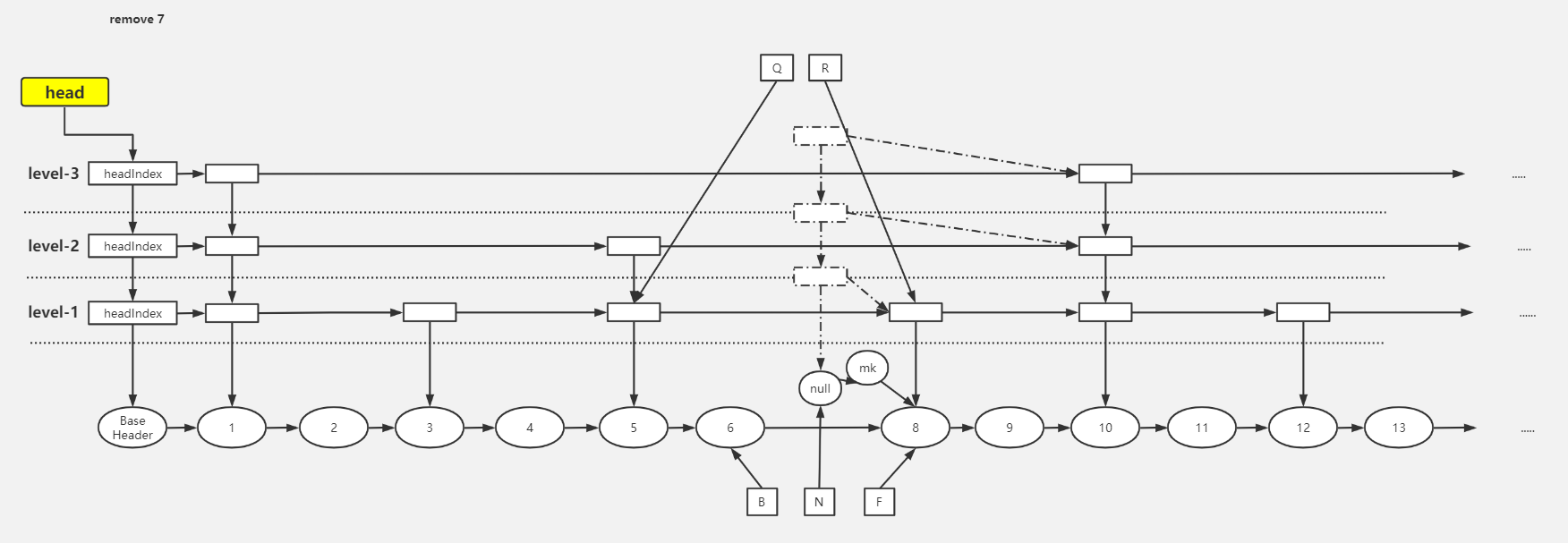
appendMarker():添加删除标记节点
1
2
3
4boolean appendMarker(Node<K,V> f) {
// 通过 CAS 让 n.next 指向一个 key 为 null,value 为 this,next 为 f 的标记节点
return casNext(f, new Node<K,V>(f));
}helpDelete():将添加了删除标记的节点清除,参数是该节点的前驱和后继节点
1
2
3
4
5
6
7
8
9
10
11void helpDelete(Node<K,V> b, Node<K,V> f) {
// this 节点的后续节点为 f,且本身为 b 的后续节点,一般都是正确的,除非被别的线程删除
if (f == next && this == b.next) {
// 如果 n 还还没有被标记
if (f == null || f.value != f)
casNext(f, new Node<K,V>(f));
else
// 通过 CAS,将 b 的下一个节点 n 变成 f.next,即成为图中的样式
b.casNext(this, f.next);
}
}tryReduceLevel():删除索引
1
2
3
4
5
6
7
8
9
10
11
12
13
14
15
16
17private void tryReduceLevel() {
HeadIndex<K,V> h = head;
HeadIndex<K,V> d;
HeadIndex<K,V> e;
if (h.level > 3 &&
(d = (HeadIndex<K,V>)h.down) != null &&
(e = (HeadIndex<K,V>)d.down) != null &&
e.right == null &&
d.right == null &&
h.right == null &&
// 设置头索引
casHead(h, d) &&
// 重新检查
h.right != null)
// 重新检查返回true,说明其他线程增加了索引层级,把索引头节点设置回来
casHead(d, h);
}
参考文章:ConcurrentSkipListMap 跳表原理解析
NoBlocking
并发编程中,需要用到安全的队列,实现安全队列可以使用 2 种方式:
- 加锁,这种实现方式是阻塞队列
- 使用循环 CAS 算法实现,这种方式是非阻塞队列
ConcurrentLinkedQueue 是一个基于链接节点的无界线程安全队列,采用先进先出的规则对节点进行排序,当添加一个元素时,会添加到队列的尾部,当获取一个元素时,会返回队列头部的元素
补充:ConcurrentLinkedDeque 是双向链表结构的无界并发队列
ConcurrentLinkedQueue 使用约定:
- 不允许 null 入列
- 队列中所有未删除的节点的 item 都不能为 null 且都能从 head 节点遍历到
- 删除节点是将 item 设置为 null,队列迭代时跳过 item 为 null 节点
- head 节点跟 tail 不一定指向头节点或尾节点,可能存在滞后性
ConcurrentLinkedQueue 由 head 节点和 tail 节点组成,每个节点由节点元素和指向下一个节点的引用组成,组成一张链表结构的队列
1 | private transient volatile Node<E> head; |
构造方法
1 | public ConcurrentLinkedQueue() { |
入队方法
与传统的链表不同,单线程入队的工作流程:
- 将入队节点设置成当前队列尾节点的下一个节点
- 更新 tail 节点,如果 tail 节点的 next 节点不为空,则将入队节点设置成 tail 节点;如果 tail 节点的 next 节点为空,则将入队节点设置成 tail 的 next 节点,所以 tail 节点不总是尾节点,存在滞后性
1 | public boolean offer(E e) { |
图解入队:
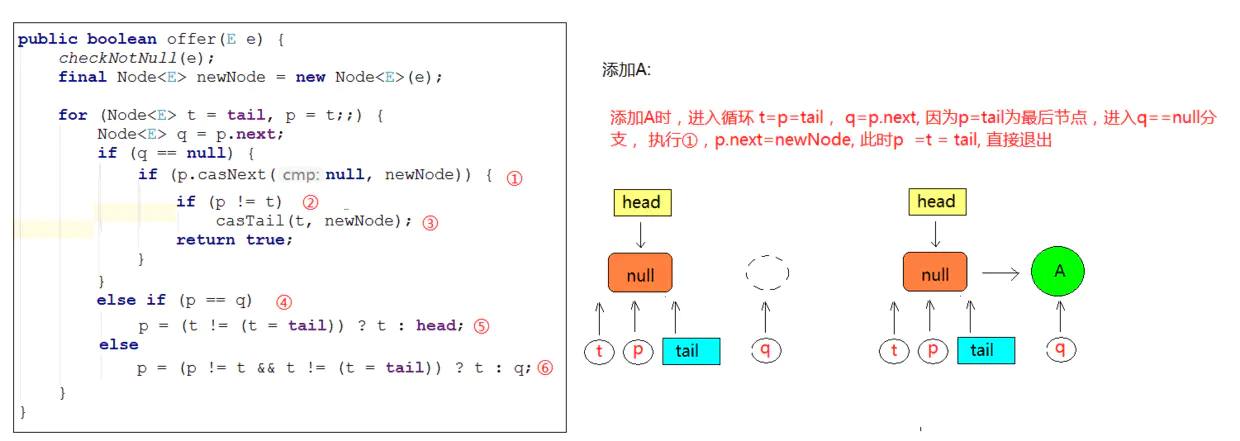
当 tail 节点和尾节点的距离大于等于 1 时(每入队两次)更新 tail,可以减少 CAS 更新 tail 节点的次数,提高入队效率
线程安全问题:
- 线程 1 线程 2 同时入队,无论从哪个位置开始并发入队,都可以循环 CAS,直到入队成功,线程安全
- 线程 1 遍历,线程 2 入队,所以造成 ConcurrentLinkedQueue 的 size 是变化,需要加锁保证安全
- 线程 1 线程 2 同时出列,线程也是安全的
出队方法
出队列的就是从队列里返回一个节点元素,并清空该节点对元素的引用,并不是每次出队都更新 head 节点
- 当 head 节点里有元素时,直接弹出 head 节点里的元素,而不会更新 head 节点
- 当 head 节点里没有元素时,出队操作才会更新 head 节点
批处理方式可以减少使用 CAS 更新 head 节点的消耗,从而提高出队效率
1 | public E poll() { |
在更新完 head 之后,会将旧的头结点 h 的 next 域指向为 h,图中所示的虚线也就表示这个节点的自引用,被移动的节点(item 为 null 的节点)会被 GC 回收
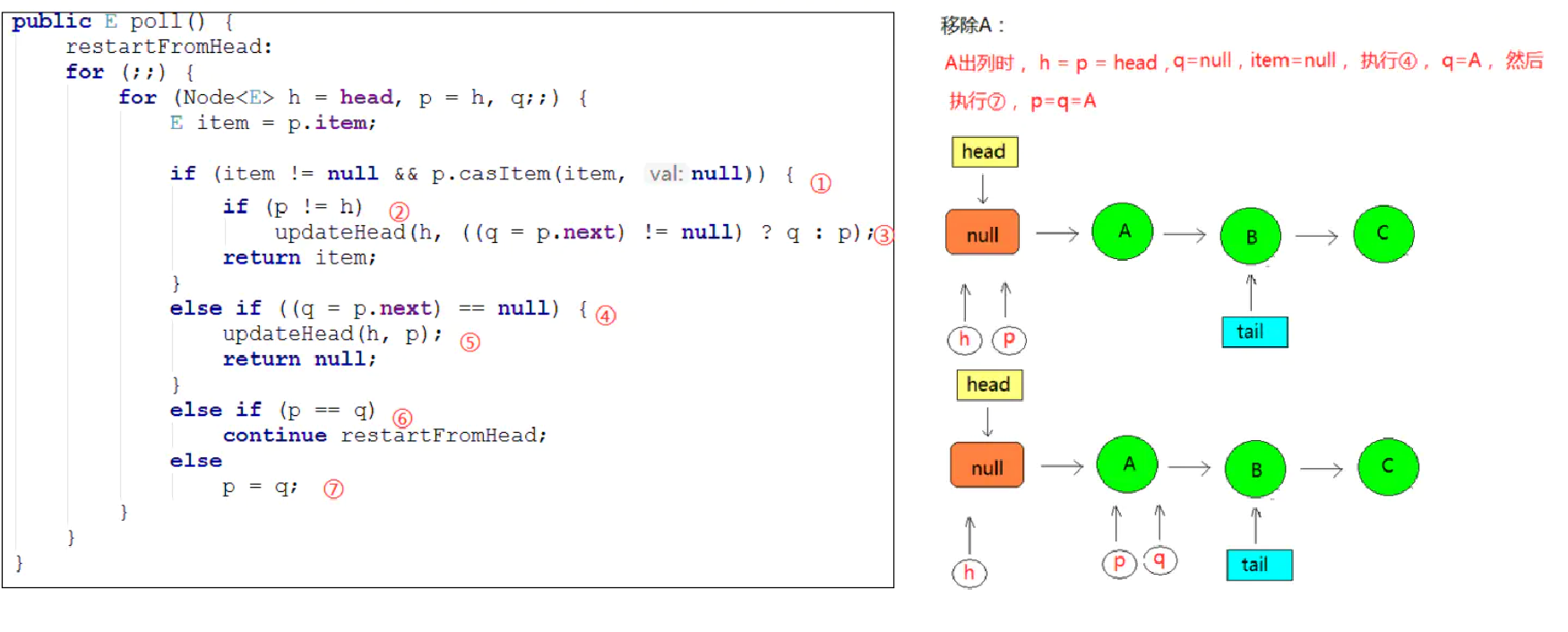
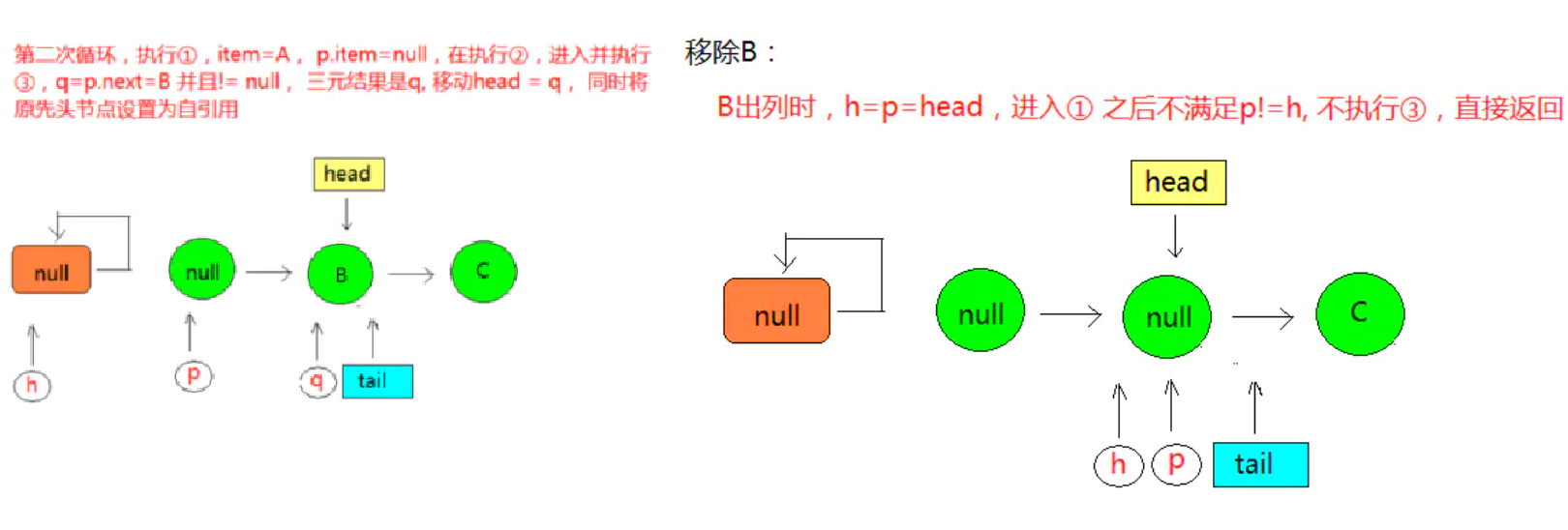

如果这时,有一个线程来添加元素,通过 tail 获取的 next 节点则仍然是它本身,这就出现了p == q 的情况,出现该种情况之后,则会触发执行 head 的更新,将 p 节点重新指向为 head
成员方法
peek():会改变 head 指向,执行 peek() 方法后 head 会指向第一个具有非空元素的节点
1
2
3
4
5
6
7
8
9
10
11
12
13
14
15
16
17
18// 获取链表的首部元素,只读取而不移除
public E peek() {
restartFromHead:
for (;;) {
for (Node<E> h = head, p = h, q;;) {
E item = p.item;
if (item != null || (q = p.next) == null) {
// 更改h的位置为非空元素节点
updateHead(h, p);
return item;
}
else if (p == q)
continue restartFromHead;
else
p = q;
}
}
}size():用来获取当前队列的元素个数,因为整个过程都没有加锁,在并发环境中从调用 size 方法到返回结果期间有可能增删元素,导致统计的元素个数不精确
1
2
3
4
5
6
7
8
9
10
11
12public int size() {
int count = 0;
// first() 获取第一个具有非空元素的节点,若不存在,返回 null
// succ(p) 方法获取 p 的后继节点,若 p == p.next,则返回 head
// 类似遍历链表
for (Node<E> p = first(); p != null; p = succ(p))
if (p.item != null)
// 最大返回Integer.MAX_VALUE
if (++count == Integer.MAX_VALUE)
break;
return count;
}remove():移除元素
1
2
3
4
5
6
7
8
9
10
11
12
13
14
15
16
17
18
19
20
21
22
23
24
25
26
27
28public boolean remove(Object o) {
// 删除的元素不能为null
if (o != null) {
Node<E> next, pred = null;
for (Node<E> p = first(); p != null; pred = p, p = next) {
boolean removed = false;
E item = p.item;
// 节点元素不为null
if (item != null) {
// 若不匹配,则获取next节点继续匹配
if (!o.equals(item)) {
next = succ(p);
continue;
}
// 若匹配,则通过 CAS 操作将对应节点元素置为 null
removed = p.casItem(item, null);
}
// 获取删除节点的后继节点
next = succ(p);
// 将被删除的节点移除队列
if (pred != null && next != null) // unlink
pred.casNext(p, next);
if (removed)
return true;
}
}
return false;
}
参考博文